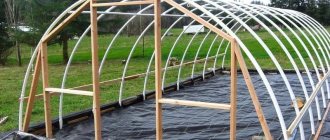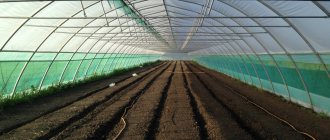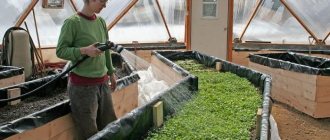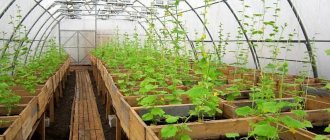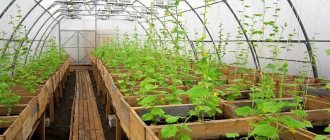The heating of the greenhouse allows it to be used for growing various crops throughout the year. This makes it possible to obtain up to three harvests per year and grow a variety of heat-loving exotic plants, creating optimal conditions for their development.
Greenhouse stove
Greenhouses can be heated in different ways. Each option has a number of important features and advantages. Find out about the most popular heating methods, learn tips on choosing the best option, and get to work.
Comparative characteristics of fuel costs
What to consider when choosing a heating system?
When choosing a heating system, you need to pay attention to the overall dimensions of the room and its type, because For different materials, the required heating intensity will also vary. For example, polyethylene is characterized by high heat loss, so a greenhouse made of this material will require more intense heating compared to a greenhouse made of polycarbonate.
Polycarbonate greenhouse
When arranging heating for a greenhouse, take into account the total costs of installing the system and its maintenance. Some heating options require significant financial investments, and their use in small greenhouses will not be practical. Others are simple and inexpensive to install, but consume a lot of fuel during operation.
Greenhouse heating
Otherwise, the owner must decide for himself how beneficial the use of one or another heating option will be specifically for his situation. The main thing is that the system ensures uniform distribution of heat throughout the room, does not dry out the air and creates optimal conditions for the development of grown crops.
Most energy efficient design
An excellent solution is a “thermos”. She is endowed with a huge number of positive qualities. The main thing is significant savings and heat conservation.
It operates 12 months a year. It is not afraid of frosts and northern winds, and is capable of supplying not only food, but also becoming a source of income. She has the following positive qualities:
- Fresh vegetables will delight you all year round.
- Works in any climate.
- Excellently transmits sunlight, distributing it evenly over the entire area.
- When high-quality insulation is used in construction, the sun's energy is converted into heat and can be retained for a fairly long period of time.
- Savings on utility bills.
- Thanks to its design, you can grow vegetables, perennials and exotic fruits, grape bushes.
Important! “Thermos” - almost everything is in the ground, but there is no shortage of lighting in it. Thanks to the huge window openings there is always a lot of light inside.
Greenhouse heating options
Familiarize yourself with the main features of the systems most commonly used to heat greenhouses.
Steam heating
Steam heating
This option should be considered if it is possible to connect the heating of the greenhouse to the heating system of the house.
Pipes laid from the house to the greenhouse require high-quality insulation. The boiler power reserve must be sufficient to provide the required level of heating for both the house and the greenhouse.
If the length of the pipeline between the house and the greenhouse exceeds 10 m, it is better to refuse to use such a system.
There is also a way to organize autonomous steam heating. In this case, the boiler is installed in the greenhouse. Pipes and batteries are connected to the heating unit, and the coolant supply is ensured. Water is traditionally used as a coolant.
To ensure forced circulation of water, the system is usually equipped with appropriate pumping equipment.
Air heating
Air heating
To organize air heating, air heated in the firebox of a special boiler is used. Such heating is characterized by minimal monetary costs for fuel and high thermal efficiency.
Air heating
About half an hour after starting the equipment, the air temperature in the greenhouse can rise by 20 degrees. An additional advantage of the system is that there is no need to use any intermediate coolants.
Air heating is best suited for regions with mild climates. In more severe conditions, it is recommended to use a combination of air and steam heating.
Gas heating
Gas heating
In such a system, heat is generated as a result of gas combustion. The system can be configured either by connecting to a permanently supplied gas or by using fuel in cylinders.
Gas heater
During operation of the system, there is an intensive intake of air from the heated room, accompanied by the release of water, carbon dioxide and other waste that pose a danger to humans and, of course, plants. In view of this, the installation of gas heating will entail additional costs for organizing the ventilation system.
This type of heating is well suited for small greenhouses. When used over large areas, the costs and complexity of maintenance may be prohibitively high.
Electric heating
Electric heating
Modern electric heating units allow you to efficiently heat a greenhouse without much effort.
Experts recommend giving preference to infrared lamps and heaters.
Among the main advantages of such devices, it should be noted that during their operation, only the heating of plants and soil occurs. The air does not warm up. It gradually receives heat from the heated earth. This allows you to equip the most efficient and economical heating system.
IR heaters
Modern systems are equipped with sensors and temperature controllers, which provide ample opportunities for dividing the greenhouse into different thermal zones and providing the most comfortable conditions for each group of plants.
Prices for popular models of infrared heaters
IR heaters
Stove heating
Stove for a greenhouse
The main unit in such a heating system is a solid fuel boiler, usually burning wood or coal.
The simplest stove heating system includes a solid fuel boiler and a smoke exhaust pipe leading from the greenhouse to the street. Additionally, you can equip the system with pipes and radiators, which will allow you to organize the most efficient and high-quality heating.
The chimney needs regular cleaning of fuel combustion products.
Both conventional wood-burning stoves and modern long-burning boilers are available on the market. Such devices do not require frequent fuel supply and use it as efficiently as possible.
Installing a solid fuel boiler directly in the greenhouse will lead to drying out of the air and soil, as a result of which the cultivated plants may simply die. To prevent this from happening, when installing a solid fuel boiler in a greenhouse, it is necessary to equip an air humidification system. Usually it is enough to install a large container of water.
Stove heating
Stove heating of a greenhouse is the most popular heating option. In addition, there is nothing complicated in setting up such a system - even a novice master can handle the job. Also, solid fuel heating unconditionally outperforms electric heating in terms of cost. That is why the procedure for organizing heating of a greenhouse will be considered using the example of stove heating.
Foundation
The greenhouse building has a heavy structure and requires laying a foundation for strength. There are 4 ways to base it:
- tape;
- brick;
- squared;
- stone foundation.
Practice shows that the most common is a strip foundation.
Work order:
- Construction site marking;
- digging a ditch about a meter deep;
- covering the bottom of the pit with waterproofing;
- production of reinforcement to strengthen the foundation;
- filling the ditch with cement mortar;
- coating of thermal insulation material on a completely hardened foundation.
Next, bolts are attached to the prepared foundation to construct the frame. When deciding how to build a winter greenhouse, some craftsmen lay one layer of brick on the foundation. With this method, the bolts must pass through the brickwork and penetrate the fabricated foundation.
Arrangement of stove heating for a greenhouse
First option
Greenhouse stoves
Brick oven with hog
First step. In the vestibule of the greenhouse, lay out a brick firebox for the stove on a pre-equipped foundation.
Second phase. Lay out the chimney along the entire length of the room.
Hog base and blower chamber with side air intakes
Firebox and chimneys
Third stage. Lead the smoke exhaust pipe out of the greenhouse from the other side. As a result, combustion products will be effectively removed from the room, and the heat will remain inside.
Continuation of the firebox and covering the hog
The oven is connected through a groove to the foundation of the greenhouse
There is a water tank above the firebox
Bed on the stove
Greenhouse stove
Prices for refractory bricks
Fire brick
Second option
Greenhouse heating scheme: 1 – heating boiler;
2 – thermos tank; 3 – circulation pump; 4 – relay regulator; 5 – registers; 6 – thermocouple First step. Prepare a large metal barrel. Paint its inner surface in two layers - this will provide protection against corrosion.
Second step. Make several holes in the housing. You will connect the chimney to one of them. Others will be used to connect the tap and expansion tank.
Third step. Weld a sheet metal stove and insert it into the prepared barrel.
Fourth step. Weld a piece of pipe to the hole in the barrel to connect the chimney. The total length of the smoke exhaust structure must be at least 4-5 m.
Fifth step. Install an expansion tank on the barrel. A container with a volume of 20-30 liters will be sufficient. You can buy a tank or weld it yourself from sheet metal.
Sixth step. Install pipes throughout the greenhouse. Place the pipes on the ground in 120 cm increments. This arrangement of heating elements will contribute to effective heating of the soil in the areas where plant roots are located.
Seventh stage. Install a pump to ensure forced circulation of water through the system.
Solid fuel boiler for a greenhouse Solid fuel boiler for a greenhouse
Solid fuel boiler for greenhouse
Turn on the water supply and make sure all connections are tight. If leaks are found, seal them immediately. Only after this can you begin to test the stove and put the heating system into permanent operation.
Heating pipes
Good luck!
Video - Heating a greenhouse with your own hands
Features of installation of warm greenhouses
Depending on the purpose of the greenhouse, the method of its heating, the level of illumination and other technical characteristics are selected. Winter greenhouse structures are buildings on a foundation that can withstand strong gusts of wind and snow loads.
First, you need to decide on the place where the winter greenhouse with heating will be installed with your own hands. It could be a hillock or a hill. If the terrain is flat, then it is advisable to create an earthen embankment. This method contributes to additional heating of the greenhouse building due to the sun.
It is advisable to allocate an area for a vestibule within the building area. It will create a transition zone and cold air will not penetrate to the planted plants.
Boiler for a greenhouse from a gas cylinder
To work, you will need an empty gas cylinder, a coil (a tube in the shape of the letter U with threads at the ends), a metal grill, a shut-off valve, hinges and two metal handles for the doors. You should also prepare a chimney pipe taking into account the length of the greenhouse, a welding machine with electrodes, a drill and an angle grinder, pipes and a radiator for the heating circuit. For the front wall of the furnace you will need a small sheet of steel.
These simple devices are used to assemble a boiler with a water circuit for heating a country greenhouse.
We cut the balloon in two
We cut the balloon in two
Step 1
After making sure that the cylinder is empty, we saw it in half with a grinder. One of the parts will serve as the furnace body, and from the second we will make an ash box.
Step 2
Making a grate-grid Making a grate-grid Making a grate-grid We take the grate
, take measurements and cut it so that the resulting segment fits inside the cylinder. We secure the grate by welding. Now the stove is divided into a fuel combustion chamber (2/3 volume) and an ash pan (1/3 volume).
Step 3
Front wall
Front wall
Place the cylinder on a sheet of steel, outline it with chalk, and cut out the front wall according to the markings. Cut off 1/3 of the circle. From this piece we make the ash pan door, welding the handle and cutting out a semicircular piece for the bottom of the drawer from the second part of the cylinder.
We cut a rectangular hole in a larger piece of wall. We weld hinges, a handle and a latch (latch) to the cut-out rectangle. The door should close the firebox tightly.
Door
Firebox and ash pan door
Step 4
We install a coil (water circuit) inside the oven. We make markings for the coil, drill two holes in the upper part of the furnace to bring out the ends of the threaded pipe. We weld the coil to the metal plate and the top of the stove.
Trying on a coil
Cutting holes
We fasten the coil
We fasten the coil The coil is fixed
Step 5
We will install a chimney. Cut a hole for the pipe in the upper back of the stove. We weld the pipe to connect the chimney. We monitor the quality of the welds, otherwise the draft and operation of the boiler will be disrupted.
We weld the chimney pipe in such a way that it will pass at an angle of about 20 degrees through the entire greenhouse. The chimney will exit through the back wall of the greenhouse, rising 1 meter above the roof. Be sure to consider thermal insulation at the point of contact between the greenhouse wall and the chimney so that a fire does not occur.
We connect the chimney pipe to the stove pipe using sheet asbestos and a coupling, tightening it with wire.
Chimney hole Connected chimney
Step 6
We connect metal pipes for the water circuit to the ends of the coil brought out. The piping must contain an expansion tank and a pump that will pump water through the pipes.
Thus, the water heated in the coil will flow into the radiator, and when cooled, it will again enter the boiler. The chimney pipe will serve as an additional source of heat. Also, a long chimney will reduce heat loss, increasing the efficiency of the boiler.
Boiler piping
Installing a pump in a greenhouse heating system
Greenhouse heating diagram Example of chimney outlets through the greenhouse wall
Step 7
We install the stove in the greenhouse, having previously built a brick or concrete base and laid out a brick screen on three sides of the firebox. For stability, the furnace can be equipped with legs made from any reinforcement or rolled steel.
We load fuel into the stove, light it, adjust the draft by opening or closing the firebox/ash pan door.
Oven in action
Now the greenhouse can be used all year round

